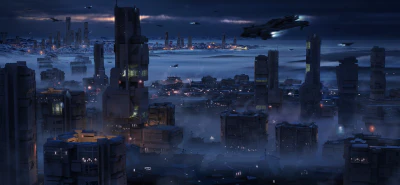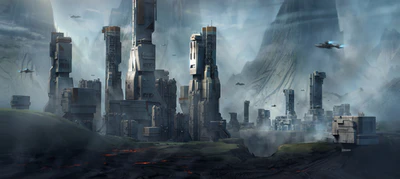
The Jump that changed the course of Humanity.
In 2271, after ten years investigating a space anomaly in the Sol System, scientist and explorer Nick Croshaw made history when he became the first known Human to traverse a jump point and enter a new star system. As a tribute to his monumental accomplishments, the system he discovered would come to bear his name.
It was a turbulent and contentious hundred years between Croshaw’s discovery and when a planet in Croshaw was terraformed. Lacking an organization to oversee expansion into the system created a plethora of issues. Humans had figured out a way to reach the stars, but were still struggling with how to inhabit them.
At first, a number of private and state-owned terraforming companies raced into Croshaw to lay claim to its planets. None of them succeeded. Each company had failed to calculate exactly how expensive it would be to continually transport supplies to maintain their operations. It was obvious that an organized Human response was needed, but, instead of focusing on a solution, countries and corporations squabbled over how land rights and mineral resources should be divided once terraforming was complete.
At the same time, there was still a good deal of fear about inter-system travel. Many people who entered the jump point between Croshaw and Sol vanished. With jump drive technology still in its infancy, ships had to be manually piloted between the two systems. Out of this, a new breed of pilot was born. Nicknamed “Jumpers,” these pilots sold themselves as the only reliable way to get between the two systems, and charged handsomely for their services. It was only after auto-piloted jump drives became widely accessible that “Jumpers” changed their focus to discovering new jump points, making them the forefathers of the “NavJumpers” that still exist today.
Amidst all the chaos and confusion, a committee appointed by the World Summit, a gathering of Earth’s leaders, finally took control of expansion into the Croshaw System. The committee organized the linking of resources from various countries and companies to tackle the terraforming of Croshaw II and Croshaw III, established a lottery to grant land and mineral rights once the process was complete, and, most importantly, figured out how to pay for it all.
The committee’s masterstroke was the Freeman Act, a piece of legislation that helped fund the terraforming of Croshaw while also populating it through the sale of one-way tickets. Not only were people buying passage aboard government-subsidized shuttles, they were guaranteed a place to live on the new planet. Sales were slow at first. While the public had acclimated to the notion of living on another planet, the thought of living in a new system entirely proved to be a truly scary concept. Further assurances eased their fears and gradually got the public excited at the prospect. The influx of ticket sales kept the committee’s terraforming fund solvent and created an entire class of people who counted down the days until they could start a new life in another system as Humanity’s first interstellar settlers.
The committee’s successful stewardship convinced Humanity’s leaders that a cohesive voice and vision was needed to aid our ascension out to the stars. In 2380, the World Summit ended with a historic announcement that created the United Nations of Earth (UNE). Humanity had realized that to succeed in the stars, we had to stop thinking of ourselves as many and start seeing ourselves as one.
Current scientific research suggests that the Icarus asteroid belt is the remainder of a planet that failed to form. Sitting between the system’s type-G main-sequence star and Croshaw I, it shields enough of the star to leave the system with a very narrow habitable zone. As one of the Empire’s oldest mining fields, there is little of value left here.
This is a planet known for its colorful yellow and orange clouds. What makes this tiny planet beautiful also makes it deadly, since the dense atmosphere is highly corrosive and toxic.
Angeli’s natural beauty is as much of a marvel today as it was when it was first discovered. The planet’s biosphere is reminiscent of Earth’s, featuring massive bodies of water and large expanses of land dotted by mountain ranges.
Angeli’s natural beauty does not come without its dangers. Geologists continue to classify the planet as a severe seismic hazard. Strict engineering codes require buildings on the planet to have extremely thick foundations and tuned mass dampers to counteract earthquakes. Even if most of the native population is apathetic about the big one, most scientist believe it is not a question of if a large earthquake will happen, but when. Due to this seismic instability, mining is severely restricted on Angeli.
Connoisseurs of fine food and spirits consider Angeli a must-stop destination. The eclectic mix of Earth’s cultures and classes during the planet’s early days created a unique cuisine. Angeli’s trademark dish is boumbo, a thick stew usually featuring either meat or seafood.
Considered a sign of true luxury, Angeli produces some of the ’verse’s most expensive whiskeys. Distilled and barreled on Earth, they are then sent to Angeli, preferably in a depressurized compartment, to complete the aging process. Bottles of Angeli whiskey sold on Earth are stamped with a special ‘round trip’ label signifying its long journey. Aficionados claim that Angeli’s light, temperature and air gives its whiskey a distinct and complex taste profile. Special facilities have been built just to store the barrels and best control their exposure to those elements. One such facility even needed to be soundproofed after neighbors complained of the loud music being blasted by the owners, who believed the vibrations helped optimize the whiskey’s time in the barrel.
Vann is far from an ideal planet for Human habitation. Located on the outer edge of Croshaw’s habitable zone, the planet is mostly frozen over and permanently cold. Yet since mining was restricted on Angeli, terraforming Vann became essential to create a source of commodities in the system.
As the Empire expanded, many residents left Vann for greener pastures. Jele City remains the planet’s most populated city, though its most prosperous days are considered long past. All things considered, it still does brisk business as an affordable tourist destination for winter sport enthusiasts.
Vann’s night skies, known for its beautiful auroras, feature a stunning curtain of colors, the result of strong solar activity reacting with the planet’s magnetosphere. Inspired by the phenomenon, a burgeoning artistic culture has made a name for itself on Vann. Many artists have set up studios in large, long-abandoned buildings. Some bought the real estate cheap, while others are simply squatting. The self-proclaimed “SpartVann” style features a minimalist aesthetic and prominent use of colors displayed in the aurora.
Planetary analysis indicates that Croshaw IV was formerly a super-Earth that lost its atmosphere. Anything of value was picked off this dead world long ago. After its resources were exhausted, locals stopped using the planet’s colloquial name and it subsequently faded from memory — a good indicator of exactly how much Croshaw IV has left to offer.
Travel Warning
Before setting out to enjoy Vann’s beautiful auroras, please make sure to wear gear that is safety-rated for extreme cold. With nighttime temperatures regularly reaching -50° Celsius, frostbite is the least of your concerns.
Heard in the Wind
"Though we might not know exactly what makes Angeli-aged whiskeys stand out, it is easy to distinguish what makes them so special. Their rich and dignified flavors excite the palette but never overpower it. It is almost as if their flavors were granted a crisp subtlety with age that has yet to be achieved anywhere else in the ’verse."
David Kurtz, A Beginner’s Guide to Angeli-Aged Whiskey, 2912
"What we do here will shape the future of interstellar expansion. Let’s make sure we get this right."
Clarence Ludwig, Chair of the Croshaw Expansion Committee, 06.23.2281
